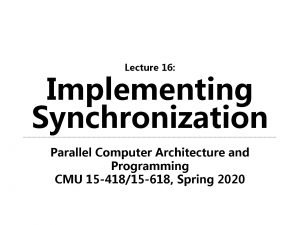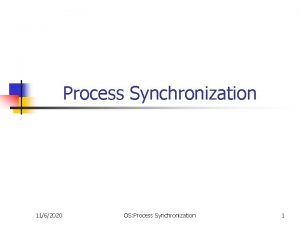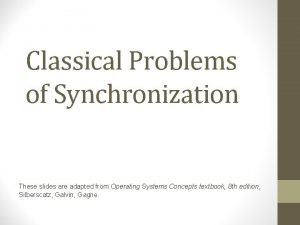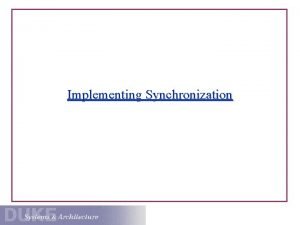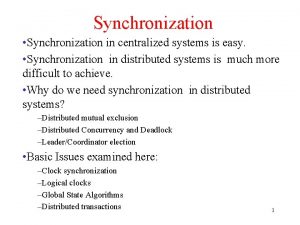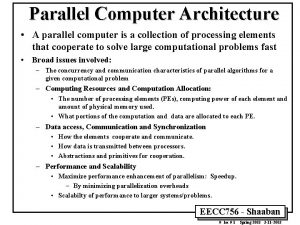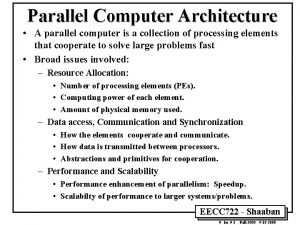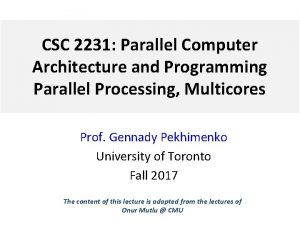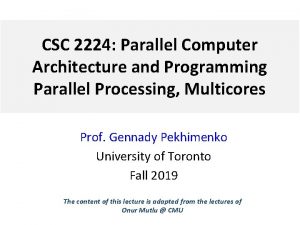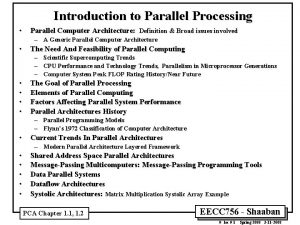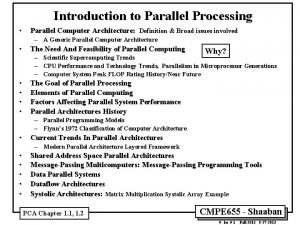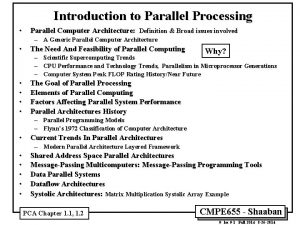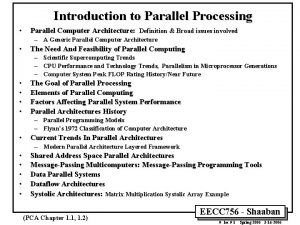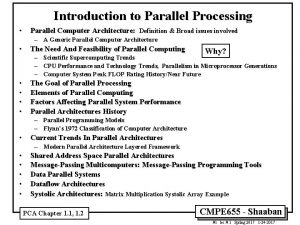Lecture 16 Implementing Synchronization Parallel Computer Architecture and













![Warm up: a simple, but incorrect, spin lock: ld R 0, mem[addr] // load Warm up: a simple, but incorrect, spin lock: ld R 0, mem[addr] // load](https://slidetodoc.com/presentation_image_h/1fb5bf7b48133509b140985780e0f0bc/image-14.jpg)

![Test-and-set based lock Atomic test-and-set instruction: ts R 0, mem[addr] // load mem[addr] into Test-and-set based lock Atomic test-and-set instruction: ts R 0, mem[addr] // load mem[addr] into](https://slidetodoc.com/presentation_image_h/1fb5bf7b48133509b140985780e0f0bc/image-16.jpg)





















- Slides: 37

Lecture 16: Implementing Synchronization Parallel Computer Architecture and Programming CMU 15 -418/15 -618, Spring 2020

Review: how threads map to cores… Let’s say I have a processor with 4 cores, with 2 execution contexts per core. again! In each clock, each core executes N instructions (from either/both execution contexts) Fetch/ Decode Exec 1 Executio n Context Executio n Context L 1 Cache L 2 Cache On-chip interconnect L 3 Cache Memory Controller Memory Bus (to DRAM) CMU 15 -418/618, Spring 2020

I can run many programs on this computer concurrently For example, let’s take a look at what’s running on a typical Mac. Many processes, many of which has spawned many logical threads. Many more logical threads than cores (and more threads than HW Who is responsible execution contexts) for choosing what threads execute on the processor? CMU 15 -418/618, Spring 2020

What does running one thread entail? ▪ A processor runs a logical thread by executing its instructions within a hardware execution context. ▪ If the operating system wants thread T of process P to run, it: 1. Chooses a CPU execution context 2. It sets the register values in that context to the last state of the thread (e. g. , sets PC to point to next instruction the thread must run, sets stack pointer, VM mappings, etc. ) 3. Then the processor starts running… It grabs the next instruction according to the PC, and executes it: - - If the instruction is: add r 0, r 1, r 2; then the processor adds the contexts of r 1 and r 2 and stores the result in r 0 If the instruction is: ld r 0 mem[r 1]; then the processor takes contents of r 1, translates it to a physical address according to the page tables referenced by the execution context, and loads the value at that address into r 0 Etc… CMU 15 -418/618, Spring 2020

The operating system maps logical threads to execution contexts Since there are more threads than execution contexts, the operating system must interleave execution of threads on the processor Periodically… the OS: 1. Interrupts the processor 2. Copies the register state of threads currently mapped to execution contexts to OS data structures in memory 3. Copies the register state of other threads it now wants to run onto the processors execution context registers 4. Tell the processor to continue - Now these logical threads are running on the processor CMU 15 -418/618, Spring 2020

How do 2 execution contexts run on a core that can only run one instruction per clock? ▪ Fetch/ Decode Exec 1 Executio n Context Executio n Context L 1 Cache L 2 Cache On-chip interconnect L 3 Cache Memory Controller Memory Bus (to DRAM) CMU 15 -418/618, Spring 2020

Output of ‘less /proc/cpuinfo’ on latedays Linux reports it is running on a - Dual CPU (two socket) - Six-cores per CPU, two threads per core Linux has 24 execution contexts to fill machine with 24 “logical processors” (corresponding to the 24 execution contexts available on the machine) … CMU 15 -418/618, Spring 2020

Today’s topic: efficiently implementing synchronization primitives ▪ Primitives for ensuring mutual exclusion - Locks - Atomic primitives (e. g. , atomic_add) - Transactions (later in the course) ▪ Primitives for event signaling - Barriers - Flags CMU 15 -418/618, Spring 2020

Three phases of a synchronization event 1. Acquire method - How a thread attempts to gain access to protected resource 2. Waiting algorithm - How a thread waits for access to be granted to shared resource 3. Release method - How thread enables other threads to gain resource when its work in the synchronized region is complete CMU 15 -418/618, Spring 2020

Busy waiting ▪ Busy waiting (a. k. a. “spinning”) while (condition X not true) {} logic that assumes X is true ▪ In classes like 15 -213 or in operating systems, you have certainly also talked about synchronization - You might have been taught busy-waiting is bad: why? CMU 15 -418/618, Spring 2020

“Blocking” synchronization ▪ Idea: if progress cannot be made because a resource cannot be acquired, it is desirable to free up execution resources for another thread (preempt the running thread) if (condition X not true) block until true; // OS scheduler de-schedules thread // (lets another thread use the processor) ▪ pthreads mutex example pthread_mutex_t mutex; pthread_mutex_lock(&mutex); CMU 15 -418/618, Spring 2020

Busy waiting vs. blocking ▪ Busy-waiting can be preferable to blocking if: - Scheduling overhead is larger than expected wait time - Processor’s resources not needed for other tasks - - ▪ This is often the case in a parallel program since we usually don’t oversubscribe a system when running a performance -critical parallel app (e. g. , there aren’t multiple CPUintensive programs running at the same time) Clarification: be careful to not confuse the above statement with the value of multi-threading (interleaving execution of multiple threads/tasks to hide long latency of memory operations) with other work within the same app. Example: pthread_spinlock_t spin; pthread_spin_lock(&spin); CMU 15 -418/618, Spring 2020

Implementing Locks CMU 15 -418/618, Spring 2020
![Warm up a simple but incorrect spin lock ld R 0 memaddr load Warm up: a simple, but incorrect, spin lock: ld R 0, mem[addr] // load](https://slidetodoc.com/presentation_image_h/1fb5bf7b48133509b140985780e0f0bc/image-14.jpg)
Warm up: a simple, but incorrect, spin lock: ld R 0, mem[addr] // load word into R 0 cmp R 0, #0 // compare R 0 to 0 bnz lock // if nonzero jump to top st mem[addr], #1 // Set lock to 1 unlock: st mem[addr], #0 // store 0 to address Problem: data race because LOAD-TESTSTORE is not atomic! Processor 0 loads address X, observes 0 Processor 1 loads address X, observes 0 Processor 0 writes 1 to address X Processor 1 writes 1 to address X CMU 15 -418/618, Spring 2020

Implementing synchronization with loads and stores ▪ It is possible to implement mutex (lock) via only loads and stores - At least with Sequential Consistency ▪ However, doing so is quite tricky, even for just 2 threads! ▪ Instead, architecture adds new instructions to support synchronization more efficiently CMU 15 -418/618, Spring 2020
![Testandset based lock Atomic testandset instruction ts R 0 memaddr load memaddr into Test-and-set based lock Atomic test-and-set instruction: ts R 0, mem[addr] // load mem[addr] into](https://slidetodoc.com/presentation_image_h/1fb5bf7b48133509b140985780e0f0bc/image-16.jpg)
Test-and-set based lock Atomic test-and-set instruction: ts R 0, mem[addr] // load mem[addr] into R 0 // if mem[addr] is 0, set mem[addr] to 1 lock: ts R 0, mem[addr] // load word into R 0 bnz R 0, lock // if 0, lock obtained unlock: st mem[addr], #0 // store 0 to address CMU 15 -418/618, Spring 2020

Test & Set in x 86 btsq $0 (%rax) ▪ Set CF to bit 0 of addressed data ▪ Set bit 0 of addressed data to 1 CMU 15 -418/618, Spring 2020

Test-and-set lock: consider coherence traffic Processor 1 Processor 2 Processor 3 Bus. Rd. X T&S Invalidate line Update line in cache (set to 1) Invalidate line T&S Bus. Rd. X Attempt to update (t&s fails) Invalidate line [P 1 is holding lock. . . ] T&S Bus. Rd. X Attempt to update (t&s fails) Invalidate line T&S Bus. Rd. X Attempt to update (t&s fails) Bus. Rd. X Update line in cache (set to 0) Invalidate line = thread has lock Invalidate line T&S Bus. Rd. X Update line in cache (set to 1) CMU 15 -418/618, Spring 2020

Check your understanding ▪ On the previous slide, what is the duration of time thread running on P 1 holds the lock? ▪ At what points in time does P 1’s cache contain a valid copy of the cache line containing the lock variable? CMU 15 -418/618, Spring 2020

Test-and-set lock performance Benchmark: execute a total of N lock/unlock sequences (in aggregate) by P processors Critical section time removed so graph plots only time acquiring/releasing the lock Time (us) Benchmark executes: lock(L); critical-section(c) unlock(L); Bus contention increases amount of time to transfer lock (lock holder must wait to acquire bus to release) Not shown: bus contention also slows down execution of critical section Number of processors Figure credit: Culler, Singh, and Gupta CMU 15 -418/618, Spring 2020

Desirable lock performance characteristics ▪ Low latency - If lock is free and no other processors are trying to acquire it, a processor should be able to acquire the lock quickly ▪ Low interconnect traffic - If all processors are trying to acquire lock at once, they should acquire the lock in succession with as little traffic as possible ▪ Scalability - Latency / traffic should scale reasonably with number of processors ▪ Low storage cost ▪ Fairness - Avoid starvation or substantial unfairness One ideal: processors should acquire lock in the order they request access to it Simple test-and-set lock: low latency (under low contention), high traffic, poor scaling, low storage cost (one int), no provisions for fairness CMU 15 -418/618, Spring 2020

Test-and-test-and-set lock void Lock(volatile int* lock) { while (1) { while (*lock != 0); if (test_and_set(lock) == 0) return; } } // while another processor has the lock. . . // when lock is released, try to acquire it void Unlock(volatile int* lock) { *lock = 0; } CMU 15 -418/618, Spring 2020

Test-and-test-and-set lock: coherence traffic Processor 1 Processor 2 Processor 3 Bus. Rd. X T&S Invalidate line Bus. Rd [Many reads from local cache] Invalidate line Bus. Rd. X Invalidate line Update line in cache (set to 1) [P 1 is holding lock. . . ] Bus. Rd. X Update line in cache (set to 0) Invalidate line Bus. Rd T&S Update line in cache (set to 1) Invalidate line Bus. Rd. X T&S Attempt to update (t&s fails) = thread has lock CMU 15 -418/618, Spring 2020

Test-and-test-and-set characteristics ▪ Slightly higher latency than test-and-set in uncontended case - Must test. . . then test-and-set ▪ Generates much less interconnect traffic - Suppose total of P threads want access to their critical sections - One invalidation, per waiting processor, per lock release (O(P) invalidations) - Total of O(P 2) interconnect traffic to handle all P threads. - (Or O(P) with a broadcast network like a bus) - Recall: test-and-set lock generated one invalidation per waiting processor per test ▪ More scalable (due to less traffic) ▪ Storage cost unchanged (one int) ▪ Still no provisions for fairness CMU 15 -418/618, Spring 2020

Test-and-set lock with back off Upon failure to acquire lock, delay for awhile before retrying void Lock(volatile int* lock) { int amount = 1; while (1) { if (test_and_set(lock) == 0) return; delay(amount); amount *= 2; } } ▪ Same uncontended latency as test-and-set, but potentially ▪ ▪ higher latency under contention. Why? Generates less traffic than test-and-set (not continually attempting to acquire lock) Improves scalability (due to less traffic) Storage cost unchanged (still one int for lock) Exponential back-off can cause severe unfairness - Newer requesters back off for shorter intervals CMU 15 -418/618, Spring 2020

Atomic increment vs Lock ▪ Task: Sum elements of array A ▪ Using mutex: volatile int sum; int A[n]; lock mutex; for (int i = 0; i < n/nthread; i++) { lock(&mutex); sum += A[i + myid*n/nthread]; unlock(&mutex); } ▪ Atomic increment for (int i = 0; i < n/nthread; i++) atomic_increment(&sum, A[i + myid*nthread]); - Direct hardware support Single bus transaction (Rd. X) CMU 15 -418/618, Spring 2020

Atomic Increment in GCC / x 86 type __sync_fetch_and_add (type *ptr, type value) type __sync_add_and_fetch (type *ptr, type value) ▪ From: https: //gcc. gnu. org/onlinedocs/gcc 4. 1. 2/gcc/Atomic-Builtins. html ▪ type is an integral type ▪ Returns pre- or post-incremented value ▪ Variants: - Add, Subtract, Bitwise-OR, Bitwise-AND, Bitwise-XOR int fadd(int *loc, int val) { return __sync_fetch_and_add(loc, val); } 00000000 <fadd>: 0: 89 f 0 mov %esi, %eax 2: f 0 0 f c 1 07 lock xadd %eax, (%rdi) 6: c 3 retq CMU 15 -418/618, Spring 2020

Ticket lock Main problem with test-and-set style locks: upon release, all waiting processors attempt to acquire lock using test-and-set struct lock { volatile int next_ticket; volatile int now_serving; }; void Lock(lock* lock) { int my_ticket = atomic_increment(&lock->next_ticket); // take a “ticket” while (my_ticket != lock->now_serving); // wait for number } // to be called void unlock(lock* lock) { lock->now_serving++; } Single atomic operation needed to acquire the lock Single write to release lock O(P) total interconnect traffic for all P threads Fairness guaranteed, too! CMU 15 -418/618, Spring 2020

Array-based lock Each processor spins on a different memory address Utilizes atomic operation to assign address on attempt to acquire struct lock { volatile int status[PMAX][W]; // padded to keep off same cache line volatile int head; }; int my_element; void Lock(lock* lock) { my_element = atomic_increment(&lock->head); while (lock->status[my_element % PMAX][0] == 1); } void unlock(lock* lock) { lock->status[my_element % PMAX][0] = 1; lock->status[(my_element+1) % PMAX][0] = 0; } O(1) interconnect traffic per release, but lock requires space linear in P CMU 15 -418/618, Also, must know upper limit on number of threads PMAX Spring 2020

Implementing Barriers CMU 15 -418/618, Spring 2020

Barrier Attempt #1 (Based on shared counter) struct Barrier_t { LOCK lock; int counter; // initialize to 0 int flag; // the flag field should probably be padded to // sit on its own cache line. Why? }; // barrier for P threads void Barrier(Barrier_t* b, int P) { lock(b->lock); if (b->counter == 0) { b->flag = 0; // first thread arriving at barrier clears flag } int num_arrived = ++(b->counter); unlock(b->lock); if (num_arrived == P) { // last arriver sets flag b->counter = 0; b->flag = 1; } else { while (b->flag == 0); // wait for flag } } Does it work? Consider: do stuff. . . Barrier(b, P); do more stuff. . . Barrier(b, P); CMU 15 -418/618, Spring 2020

Barrier #2: Correct struct Barrier_t { LOCK lock; int arrive_counter; // initialize to 0 (number of threads that have arrived) int leave_counter; // initialize to P (number of threads that have left barrier) int flag; }; // barrier for P threads void Barrier(Barrier_t* b, int P) { lock(b->lock); if (b->arrive_counter == 0) { // if first to arrive. . . if (b->leave_counter == P) { // check to make sure no other threads “still in barrier” b->flag = 0; // first arriving thread clears flag } else { unlock(lock); while (b->leave_counter != P); // wait for all threads to leave before clearing lock(lock); b->flag = 0; // first arriving thread clears flag (How many can do this? ) } } int num_arrived = ++(b->arrive_counter); unlock(b->lock); if (num_arrived == P) { // last arriver sets flag b->arrive_counter = 0; b->leave_counter = 1; b->flag = 1; } else { while (b->flag == 0); // wait for flag lock(b->lock); b->leave_counter++; unlock(b->lock); } } Main idea: wait for all processes to leave first barrier, before clearing flag for entry into the second CMU 15 -418/618, Spring 2020

#3: Centralized barrier with sense reversal struct Barrier_t { LOCK lock; int counter; // initialize to 0 int flag; // initialize to 0 }; int local_sense = 0; // private per processor. Main idea: processors wait for flag // to be equal to local sense // barrier for P threads void Barrier(Barrier_t* b, int P) { local_sense = (local_sense == 0) ? 1 : 0; lock(b->lock); int num_arrived = ++(b->counter); if (b->counter == P) { // last arriver sets flag unlock(b->lock); b->counter = 0; b->flag = local_sense; } else { unlock(b->lock); while (b->flag != local_sense); // wait for flag } Sense reversal optimization results in one spin instead of two CMU 15 -418/618, Spring 2020

Centralized barrier: traffic ▪ O(P) traffic on interconnect per barrier: - - All threads: 2 P write transactions to obtain barrier lock and update counter - O(P) traffic assuming lock acquisition is implemented in O(1) manner Last thread: 2 write transactions to write to the flag and reset the counter - O(P) traffic since there are many sharers of the flag P-1 transactions to read updated flag ▪ But there is still serialization on a single shared lock - So span (latency) of entire operation is O(P) Can we do better? CMU 15 -418/618, Spring 2020

Combining tree implementation of barrier High contention! (e. g. , single barrier lock and counter) Centralized Barrier Combining Tree Barrier ▪ Combining trees make better use of parallelism in interconnect topologies - lg(P) span (latency) - ▪ Strategy makes less sense on a bus (all traffic still serialized on single shared bus) Barrier acquire: when processor arrives at barrier, performs increment of parent counter - Process recurses to root ▪ Barrier release: beginning from root, notify children of release CMU 15 -418/618, Spring 2020

Coming up… ▪ Imagine you have a shared variable for which ▪ ▪ contention is low. So it is unlikely that two processors will enter the critical section at the same time? You could hope for the best, and avoid the overhead of taking the lock since it is likely that mechanisms for ensuring mutual exclusion are not needed for correctness - Take a “optimize-for-the-common-case” attitude What happens if you take this approach and you’re wrong: in the middle of the critical region, another process enters the same CMU 15 -418/618, region? Spring 2020

Preview: transactional memory atomic { // begin transaction perform atomic computation here. . . } // end transaction Instead of ensuring mutual exclusion via locks, system will proceed as if no synchronization was necessary. (it speculates!) System provides hardware/software support for “rolling back” all loads and stores in the critical region if it detects (at run-time) that another thread has entered same region at the same time. CMU 15 -418/618, Spring 2020
 Synchronization in computer architecture
Synchronization in computer architecture Designing and implementing brand marketing programs
Designing and implementing brand marketing programs Brand hierarchy tree
Brand hierarchy tree Designing and implementing brand architecture strategies
Designing and implementing brand architecture strategies Computer architecture lecture notes
Computer architecture lecture notes Computer architecture lecture
Computer architecture lecture 01:640:244 lecture notes - lecture 15: plat, idah, farad
01:640:244 lecture notes - lecture 15: plat, idah, farad The computer system and its interconnection structures
The computer system and its interconnection structures Organization and architecture difference
Organization and architecture difference Bus architecture in computer organization
Bus architecture in computer organization Cloud computing lecture
Cloud computing lecture Flowchart for memory reference instructions
Flowchart for memory reference instructions Synchronization algorithms and concurrent programming
Synchronization algorithms and concurrent programming Chapter 7 strategic management
Chapter 7 strategic management Mis issues in strategy implementation
Mis issues in strategy implementation Chapter 7 strategic management
Chapter 7 strategic management Tripod pricing strategy
Tripod pricing strategy Crm vision statement example
Crm vision statement example Matching structure with strategy
Matching structure with strategy Implementing strategies management and operations issues
Implementing strategies management and operations issues Unlike parallel forces definition
Unlike parallel forces definition Annie's dress was old, faded, and it had wrinkles.
Annie's dress was old, faded, and it had wrinkles. Means?
Means? Parallel structure means using the same pattern of
Parallel structure means using the same pattern of Parallelism definition
Parallelism definition Computer security 161 cryptocurrency lecture
Computer security 161 cryptocurrency lecture Computer aided drug design lecture notes
Computer aided drug design lecture notes Parallel and distributed database architecture
Parallel and distributed database architecture Parallel and distributed database architecture
Parallel and distributed database architecture Fast clock to slow clock synchronization
Fast clock to slow clock synchronization Is high level synchronization construct
Is high level synchronization construct Process synchronization in os
Process synchronization in os Tally synchronization
Tally synchronization Multiprocessor synchronization
Multiprocessor synchronization Lean synchronization
Lean synchronization Show bgp neighbor
Show bgp neighbor Lock free synchronization
Lock free synchronization Classical problems of synchronization
Classical problems of synchronization
